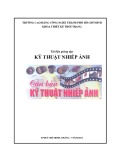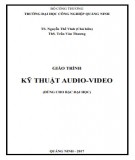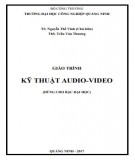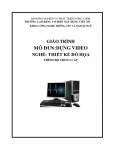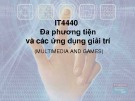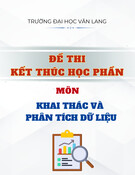IT4440 Đa phương tiện và các ứng dụng giải trí
(MULTIMEDIA AND GAMES)
Nội dung môn học
Tuần
Chủ đề
Số tiết
1
Giới thiệu về môn học
1 – 5
Phần I. Tổng quan về thông tin đa phương tiện và các kỹ thuật xử lý
15
Chương I: Nhập môn Multimedia
1
1
Chương II: Một số kiến thức cơ bản
1
1
2
Chương III: Ảnh
4
3
Chương IV: Màu
3
4
Chương V: Video
3
5
Chương VI: Audio
3
6 –
Phần II. Một số ứng dụng đa phương tiện
Chương V: Multimedia- ứng dụng và giải trí
Chương VI: Ứng dụng web
Chương VII: Ứng dụng mobile
Chương VIII: Ứng dụng 3D
Chương IX: Ứng dụng Game
Bảo vệ Bài tập lớn, Tổng kết ôn tập
Nội dung môn học
Tuần
Chủ đề
Số tiết
1
Giới thiệu về môn học
1 – 5
Phần I. Tổng quan về thông tin đa phương tiện và các kỹ thuật xử lý
15
Chương I: Nhập môn Multimedia
1
1
Chương II: Một số kiến thức cơ bản
1
1
2
Chương III: Ảnh
4
3
Chương IV: Màu
3
4
Chương V: Video
3
5
Chương VI: Audio
3
6 –
Phần II. Một số ứng dụng đa phương tiện
Chương V: Multimedia- ứng dụng và giải trí
Chương VI: Ứng dụng web
Chương VII: Ứng dụng mobile
Chương VIII: Ứng dụng 3D
Chương IX: Ứng dụng Game
Bảo vệ Bài tập lớn, Tổng kết ôn tập
Mục tiêu của chương Quá trình tạo ảnh Biểu diễn và lưu trữ ảnh Nén ảnh Một số kỹ thuật xử lý ảnh cơ bản Một số công cụ xử lý ảnh Tổng kết chương Tài liệu tham khảo
Chương III: Ảnh
Người học sẽ:
Được trang bị kiến thức về quá trình tạo ảnh, biểu diễn, nén và lưu trữ ảnh
Được giới thiệu một số kỹ thuật xử lý ảnh cơ bản, một số công cụ xử lý
Sau khi kết thúc chương, người học :
Nắm được kiến thức cơ bản của tạo ảnh, biểu diễn, lưu trữ ảnh
Biết vận dụng một số kỹ thuật, công cụ xử lý ảnh để thực hành xử lý một số ảnh cụ thể
III.1 Mục tiêu của chương
Ảnh (Bimmaped
Image) được tạo
ra như thế nào ?
III.2 Quá trình tạo ảnh
III.2 Quá trình tạo ảnh
Ống kính và điểm nhìn xác định phối cảnh Độ mở ống kính và tốc độ đóng quyết định độ sáng ảnh Độ mở và các hiệu ứng khác quyết định độ sâu ảnh Film hay cảm biến cho phép lưu ảnh
III.2 Quá trình tạo ảnh
Bộ cảm biến, film sẽ « cảm» ánh sáng từ mọi phía
III.2 Quá trình tạo ảnh
Pinhole Camera model: ánh sáng đi qua một lỗ nhỏ
III.2 Quá trình tạo ảnh
III.2 Quá trình tạo ảnh
Digital image
Digitizer
World
Camera
Quá trình tạo ảnh số (digital image)
Source : Tal Hassner. Computer Vision. Weizmann Institute of Science (Israel).
III.2 Quá trình tạo ảnh
CCD: Charge Coupled Device (Thiết bị
tích điện kép) Tiếp nhận ánh sáng tới Ánh sáng tới được chuyển thành các tín hiệu
điện
Năng lượng của tín hiệu điện tỷ lệ thuận với
lượng ánh sáng tới
Có các bộ lọc để tăng tính chọn lựa
III.2 Quá trình tạo ảnh
Cảm biến quang CCD
KAF-1600 - Kodak.
Tạo ảnh màu như thế nào ?
III.2 Quá trình tạo ảnh
Minh họa quá trình tạo ảnh RGB
Mỗi điểm ảnh trên cảm biến được coi như một thùng chứa
Các photon ánh sáng sẽ rơi vào các thùng chứa.
Cường độ sáng tỷ lệ thuận với số photon ánh sang có trong thùng chứa
III.2 Quá trình tạo ảnh
Cảm biến Bayer và Foveon
Tại sao lại có hai Green, một Blue và một Red trong mô hình Bayer ?
III.2 Quá trình tạo ảnh
III.2 Quá trình tạo ảnh
Thực sự thì camera đã « nhìn » thấy gì ?
III.2 Quá trình tạo ảnh
Để tạo thành bức ảnh giống như ta nhìn thấy, cần phải thực hiện bước « Demosaicing » Đối với mô hình Bayer, kết hợp 4 phần tử liền kề để tạo thành một điểm ảnh có giá trị RGB
III.2 Quá trình tạo ảnh
Các giá trị điện thế mà ta thu được tương ứng với đáp ứng của bộ cảm biến quang đối với môi trường quan sát Các giá trị này (Voltage) là các giá trị liên tục (Analog) Các giá trị này sẽ được số hóa để cho ta mảng các điểm, mỗi điểm có 3 giá trị (R, G, B) => Ảnh số
III.3 Ảnh số: Biểu diễn
Light → Electric charge → Number
III.3 Ảnh số: Biểu diễn
ảnh số được tạo ra như thế nào ?
Digitization = Sampling + Quantization
III.3 Ảnh số: Biểu diễn
Ảnh gốc
III.3 Ảnh số: Biểu diễn
Lấy mẫu và lượng tử hóa Cường độ sáng của đường quét ngang
Lượng tử hóa
Lấy mẫu
23
Source : Gonzalez and Woods. Digital Image Processing. Prentice-Hall, 2002.
Lấy mẫu ảnh bị giới hạn bởi kích thước của cảm biến (kích thước của ma trận điểm ảnh trên cảm biến)
Lượng tử hóa bị hạn chế bởi số mức ánh sáng định nghĩa trong một giải nào đó
Source : Gonzalez and Woods. Digital Image Processing. Prentice-Hall, 2002.
III.3 Ảnh số: Biểu diễn
Ảnh tương tự trên cảm biến
Ảnh sau khi lấy mẫu và lượng tử hóa
Source : Gonzalez and Woods. Digital Image Processing. Prentice-Hall, 2002.
III.3 Ảnh số: Biểu diễn
Ảnh được biểu diễn bởi một ma trận kích thước MxN, tương ứng với số điểm ảnh của bộ cảm biến quang Mỗi phần tử của ảnh sẽ có 1 đến 3 giá trị tùy thuộc vào ảnh mức xám (đen trắng) hay ảnh màu Các giá trị là một số nguyên nằm trong khoảng [Lmin, Lmax] Tổng số bít cần thiết để biểu diễn các mức xám trong khoảng L là K sao cho: L= 2K Tổng số bit cần để lưu trữ một ảnh là: MxNxK (bít)
III.3 Ảnh số: Biểu diễn
Độ phân giải ảnh là gì ?
III.3 Ảnh số: Độ phân giải của ảnh
Độ phân giải trong không gian
Là phần tử nhỏ nhất nhìn thấy được (kích
thước điểm ảnh)
Độ phân giải theo mức xám
Sự thay đổi màu sắc nhỏ nhất có thể quan
sát đươc
Một ảnh có độ phân giải không gian M X N điểm ảnh có độ phân giải mức xám là K bits hay L mức xám
III.3 Ảnh số: Độ phân giải của ảnh
III.3 Ảnh số: Độ phân giải của ảnh
Độ phân giải không gian
III.3 Ảnh số: Độ phân giải của ảnh
Độ phân giải mức xám
Kích thước vật lý của một ảnh khi nó được hiển thị phụ thuộc vào mật độ điểm ảnh trên thiết bị hiển thị (dpi = dots per inch)
III.3 Ảnh số: Độ phân giải của ảnh
III.3 Ảnh số: Độ phân giải của ảnh
Hầu hết các định dạng file ảnh để lưu độ phân giải ảnh cùng với giá trị các điểm ảnh, thường là độ phân giải của thiết bị thu nhận (camera)
III.3 Ảnh số: Độ phân giải của ảnh
- đen
Mức xám - 8 bits: 0 255 - trắng
III.3 Ảnh số: Lưu trữ
64 60 69 100 149 151 176 182 179 65 62 68 97 145 148 175 183 181 65 66 70 95 142 146 176 185 184 66 66 68 90 135 140 172 184 184 66 64 64 84 129 134 168 181 182 59 63 62 88 130 128 166 185 180 60 62 60 85 127 125 163 183 178 62 62 58 81 122 120 160 181 176 63 64 58 78 118 117 159 180 176
III.3 Ảnh số: Lưu trữ
x = 58 59 60 61 62 63 64 65 66 67 68 69 70 71 72
y =
210 209 204 202 197 247 143 71 64 80 84 54 54 57 58 206 196 203 197 195 210 207 56 63 58 53 53 61 62 51 201 207 192 201 198 213 156 69 65 57 55 52 53 60 50 216 206 211 193 202 207 208 57 69 60 55 77 49 62 61 221 206 211 194 196 197 220 56 63 60 55 46 97 58 106 209 214 224 199 194 193 204 173 64 60 59 51 62 56 48 204 212 213 208 191 190 191 214 60 62 66 76 51 49 55 214 215 215 207 208 180 172 188 69 72 55 49 56 52 56 209 205 214 205 204 196 187 196 86 62 66 87 57 60 48 208 209 205 203 202 186 174 185 149 71 63 55 55 45 56 207 210 211 199 217 194 183 177 209 90 62 64 52 93 52 208 205 209 209 197 194 183 187 187 239 58 68 61 51 56 204 206 203 209 195 203 188 185 183 221 75 61 58 60 60 200 203 199 236 188 197 183 190 183 196 122 63 58 64 66 205 210 202 203 199 197 196 181 173 186 105 62 57 64 63
41 42 43 44 45 46 47 48 49 50 51 52 53 54 55
Ảnh là một tín hiệu 2D (x, y) Về mặt toán học: Ảnh là một ma trận biểu diễn tín hiệu Đối với người dùng: Ảnh chứa các thông tin ngữ nghĩa (khung cảnh đường phố)
III.3 Ảnh số: Biểu diễn và lưu trữ
Ảnh tự nhiên – thu nhận từ các thiết bị camera, microscope, tomography, infrared,
satellite, … Ảnh nhân tạo –
Đồ họa máy tính (computer graphics), thực tại
ảo (virtual reality)
Ảnh tự nhiên
ảnh nhân tạo
Ảnh nhân tạo
Phân loại ảnh
Ảnh mức xám I(x,y) in [0..255]
Ảnh màu IR(x,y) IG(x,y) IB(x,y)
Ảnh nhị phân I(x,y) in {0 , 1}
Source : Tal Hassner. Computer Vision. Weizmann Institute of Science (Israel).
Phân loại ảnh
Ảnh màu trong hệ tọa độ RGB
Bên cạnh hệ tọa độ màu RGB ta còn có các hệ tọa độ màu khác
Source : Tal Hassner. Computer Vision. Weizmann Institute of Science (Israel).
Tại sao ta có thể nén ảnh ?
Tại sao cần phải nén ?
Các phương pháp thường dùng để nén ảnh ?
III.4 Nén ảnh (image compression)
Tại sao cần phải nén ?
Lượng dữ liệu ngày càng lớn
Các yêu cầu về lưu trữ và truyền thông
DVD
Video conference
Printer
Tốc độ truyền dữ liệu cinema không nén:1Gbps
III.4 Nén ảnh (image compression)
Tại sao ta có thể nén ảnh ?
Sự dư thừa thông tin theo không gian, thời gian, tần số
Các pixel lân cận không độc lập nhưng tương quan lẫn nhau
III.4 Nén ảnh (image compression)
Dư thừa thông tin trong không gian (Spatial Redundancy)
III.4 Nén ảnh (image compression)
Dư thừa thông tin theo cường độ sáng
I1
I2
Theo định luật Weber: sai khác DI = I1 – I2, chỉ có thể phân biệt được khi DI/I1 đủ lớn The high (bright) values need a less accurate representation compared to the low (dark) values
Weber’s law holds for all human senses!
III.4 Nén ảnh (image compression)
Dư thừa thông tin theo tần số
Hệ thống thị giác của con người cũng giống như một bộ lọc: Các thành phần tần số quá cao sẽ bị bỏ qua
III.4 Nén ảnh (image compression)
Nguyên lý nén ảnh là gì ? Chỉ dữ lại thông tin
REDUNDANTDATA
INFORMATION
DATA = INFORMATION + REDUNDANT DATA
III.4 Nén ảnh (image compression)
Nguyên lý nén ảnh là gì ? Chỉ dữ lại thông tin Vậy làm thế nào để phát hiện ra sự dư thừa thông tin phục vụ trong các giải thuật nén ảnh
III.4 Nén ảnh (image compression)
Mô hình chung của nén ảnh trong các hệ thống truyền và lưu trữ dữ liệu
Coder: (en)coder + decoder = codec Source encoder: removes redundancy Channel encoder: adds redundancy A/D, D/A, en/decryption optional Only deal with the source coder
III.4 Nén ảnh (image compression)
Transformation
Quantization
Input Info.
Codeword assignment
Coded bit-string
Inverse transformation
Reconstructed Information
Codeword decoder
Coded bit-string
Transformation: new representation of data
Differential coding, transform coding (MM2)
Quantization: In-reversible process => lossy coding Codeword assignment (entropy coding): Info. Theory: Huffman, run length, arithmetic, dictionary coding
Bộ mã hóa nguồn tin
After transformation and quantization => source symbols: s1, s2, s3,…, sn The symbols need to be represented by bits Remove the redundancy in the symbols (lossless) Methods: Run length, Huffman, arithmetic, modifications, dictionary (LZW: zip, gif, tiff, pdf,..) Quick introduction to run length and
Huffman coding
Codeword assignment
Input: 7,7,7,7,7,13,90,9,9,9,2,1,1,0,5,…= 15 Byte RLE: 5,7,13,90,3,9,2,2,1,0,5,…= 11 Byte How to distinguish between values and counts? One value of a byte to indicate a count, e.g. 0 or 255, e.g. 255: 255,5,7,13,90,255,3,9,2,255,2,1,0,5,…= 14 Byte One bit to indicate count [1] and value [0] for 8 values => [10001001],5,7,13,90,3,9,2,2,[000…]1,0,5.. ~ 12,5 Byte
Run length coding
Arrange symbols: p(s2) > p(s5) > … > p(s3) li = length in bits of the i’th symbol si Key idea: use fewer bits to code the most likely symbols: l2 < l5 < … < l3
Huffman coding
Algorithm:
Arrange symbols Loop:
Combine the two symbols with lowest probabilities into a new
symbol
Assign one bit and update probabilities Re-arrange symbols Codewords: back trace
Huffman coding
S ( 1.0 )
0 1
S1,6 ( 0.55 ) S5,4,2,3 ( 0.45 )
0 1
S5,4,2,3 ( 0.45 ) S1 ( 0.30 ) S6 ( 0.25 )
0 1
S1 ( 0.30 ) S6 ( 0.25 ) S5,4,2 ( 0.25 ) S3 ( 0.20 )
0 1
S1 ( 0.30 ) S6 ( 0.25 ) S3 ( 0.20 ) S5,4 ( 0.15 ) S2 ( 0.10 )
0 1
S1 ( 0.30 ) S6 ( 0.25 ) S3 ( 0.20 ) S2 ( 0.10 ) S5 ( 0.10 ) S4 ( 0.05 )
"Joint Photographic Expert Group".
Voted as international standard in 1992.
Works with color and grayscale images,
e.g., satellite, medical, ...
Lossy and lossless
III.4 Nén ảnh: JPEG
1987: ITU + ISO => international standard for still image compression, due to grows in the PC market: JPEG = Joint Photographic Expert Group Goal: non-binary images keeping a good to excellent image quality First standard in 1992 JPEG is NOT an algorithm but rather a framework with several algorithms and user-settings
III.4 Nén ảnh: JPEG
First generation JPEG uses DCT + Run length Huffman entropy coding.
Second generation JPEG (JPEG2000) uses wavelet transform + Bit plane coding + Arithmetic entropy coding.
III.4 Nén ảnh : JPEG
Các thông tin tần số cao có thể bị loại bỏ mà không làm mất mát thông tin quan sát vì mắt người không cảm nhận được những hiệu ứng do các thành phần tần số cao mang lại một cách chính xác Ảnh được chuyển sang miền tần số sử dụng phép biến đổi Cosin rời rạc - Discrete Cosine Transform (DCT). Phép biến đổi DCT thường được áp dụng cho các khối pixel kích thước 8 × 8. Việc áp dụng DCT không làm giảm kích thước của dữ liệu, vì số các hệ số của DCT cũng bằng tổng số pixel của khối (64). Tuy nhiên, các hệ số của DCT được lượng tử hóa, vì thế số bit cần thiết để biểu diễn các hệ số DCT sẽ giảm đi. Việc lượng tử hỏa sẽ làm biến mất một số thông tin.
III.4 Nén ảnh: JPEG
Tại sao là DCT mà không phải là DFT ?
DCT is similar to DFT, but can provide a better approximation with fewer coefficients
The coefficients of DCT are real valued instead of complex valued in DFT.
III.4 Nén ảnh: JPEG
III.4 Nén ảnh: JPEG
• Each 8x8 block
can be looked at as a weighted sum of these basis functions.
• The process of 2D DCT is also the process of finding those weights.
The 64 (8 X 8) DCT Basis Functions
Why? -- To group low frequency coefficients in top of vector. Maps 8 x 8 to a 1 x 64 vector.
Zig-zag Scan DCT Blocks
Ảnh gốc
Ảnh JPEG 27:1
JPEG2000 27:1
Original image
512 x 512 x 8 bits
= 2,097,152 bits
JPEG
27:1 reduction
=77,673 bits
Ví dụ về nén JPEG
130 5
-34
11
-17
14
10
4
2
47
1
-8
14
21
22
6
-19
1
-2
-3
6
3
-1
-21
-3
5
-1
5
-1
-2
17
11
7
-9
2
10
9
1
-4
9
2
4
-6
-11
12
-7
40
-17
Why is it possible to compress images? Explain the JPEG framework What is the compression factor of this luminance DCT- block?
-1
-12
-3
1
9
14
57
34
22
5
4
-2
33
-21
14
-27
Bài tập
GIF PNG JPEG TiFF BMP
Các định dạng file ảnh
là một định dạng tập tin hình ảnh bitmap cho các hình ảnh dùng ít hơn 256 màu sắc khác nhau và các hoạt hình dùng ít hơn 256 màu cho mỗi khung hình. GIF là định dạng nén dữ liệu đặc biệt hữu ích cho việc truyền hình ảnh qua đường truyền lưu lượng nhỏ. Định dạng này được CompuServe cho ra đời vào năm 1987 và nhanh chóng được dùng rộng rãi trên World Wide Web cho đến nay.
Graphics Interchange Format - GIF
Là một dạng hình ảnh sử dụng phương pháp nén dữ liệu mới - không làm mất đi dữ liệu gốc. PNG được tạo ra nhằm cải thiện và thay thế định dạng ảnh GIF với một định dạng hình ảnh không đòi hỏi phải có giấy phép sáng chế khi sử dụng. PNG được hỗ trợ bởi thư viện tham chiếu libpng, một thư viện nền tảng độc lập bao gồm các hàm của C để quản lý các hình ảnh PNG.
Portable Network Graphics - PNG
Là một trong những phương pháp nén ảnh hiệu quả, có tỷ lệ nén ảnh tới vài chục lần. Tuy nhiên ảnh sau khi giải nén sẽ khác với ảnh ban đầu. Chất lượng ảnh bị suy giảm sau khi giải nén. Sự suy giảm này tăng dần theo hệ số nén. Sự mất mát thông tin này là có thể chấp nhận được vì việc loại bỏ những thông tin không cần thiết được dựa trên những nghiên cứu về hệ nhãn thị của mắt người. Phần mở rộng của các file JPEG thường có dạng .jpeg, .jfif, .jpg, .JPG, hay .JPE; dạng .jpg là dạng được dùng phổ biến nhất. Hiện nay dạng nén ảnh JPEG rất được phổ biến trong ĐTDD cũng như những trang thiết bị lưu giữ có dung lượng nhỏ.
Joint Photographic Experts Group) - JPEG
TIFF is an extensible format, often used for storing uncompressed digital photographs, and for interchange of images.
Tagged Image File Format - TIFF
Trong đồ họa máy vi tính, BMP, còn được biết đến với tên tiếng Anh khác là Windows bitmap, là một định dạng tập tin hình ảnh khá phổ biến. Các tập tin đồ họa lưu dưới dạng BMP thường có đuôi là .BMP hoặc .DIB (Device Independent Bitmap). BMP thường là không nén
BMP
BẢNG TỔNG KẾT CÁC ĐỊNH DẠNG FILE
Color data mode - Bits per pixel
TIF
RGB - 24 or 48 bits, Grayscale - 8 or 16 bits, Indexed color - 1 to 8 bits, Line Art (bilevel)- 1 bitFor TIF files, most programs allow either no compression or LZW compression (lossless, but is less effective for 24 bit color images). Adobe Photoshop also provides JPG or ZIP compression too (but which greatly reduces third party compatibility of TIF files). "Document programs" allow ITCC G3 or G4 compression for 1 bit text (Fax is G3 or G4 TIF files), which is lossless and tremendously effective (small).
PNG
RGB - 24 or 48 bits, Grayscale - 8 or 16 bits, Indexed color - 1 to 8 bits, Line Art (bilevel) - 1 bitPNG uses ZIP compression which is lossless, and slightly more effective than LZW (slightly smaller files). PNG is a newer format, designed to be both verstile and royalty free, back when the LZW patent was disputed.
JPG
RGB - 24 bits, Grayscale - 8 bitsJPEG always uses lossy JPG compression, but its degree is selectable, for higher quality and larger files, or lower quality and smaller files.
GIF
Indexed color - 1 to 8 bitsGIF uses lossless LZW compression, effective on indexed color. GIF files contain no dpi information for printing purposes.
File format and purpose
Photographic Images
Graphics, including Logos or Line art
Properties
Photos are continuous tones, 24 bit color or 8 bit Gray, no text, few lines and edges
Graphics are often solid colors, up to 256 colors, with text or lines and sharp edges
For Unquestionable Best Quality
TIF or PNG (lossless compression and no JPG artifacts)
PNG or TIF (lossless compression, and no JPG artifacts)
Smallest File Size
JPG with a higher Quality factor can be decent.
TIF LZW or GIF or PNG (graphics/logos without gradients normally permit indexed color of 2 to 16 colors for smallest file size)
TIF or JPG
TIF or GIF
Maximum Compatibility (PC, Mac, Unix)
Worst Choice
256 color GIF is very limited color, and is a larger file than 24 bit JPG
JPG compression adds artifacts, smears text and lines and edges
III.5 Một số kỹ thuật xử lý ảnh cơ bản
Xử lý
Ảnh đầu vào
Ảnh đầu ra
Thế nào là xử lý ảnh ?
Các phép xử lý cơ bản Các bộ lọc tuyến tính Blurring Sharpening Edge detection Wiener denoising Các bộ lọc phi tuyến Median filter Bilateral filter Cross-bilateral filter
III.5 Một số kỹ thuật xử lý ảnh cơ bản
Number of pixels
Gray level
Lược đồ ảnh là phân bố các giá trị mức
xám (màu ) của một ảnh
H(k) = tổng số pixel trong ảnh có giá trị
k
Lược đồ ảnh
PI(k) 1
k
PI(k) 1
0.5
k
PI(k)
0.1
k
Image dynamic range = [min_value, max_value] Source : Tal Hassner. Computer Vision. Weizmann Institute of Science (Israel).
Lược đồ ảnh
Luminance của một ảnh được định nghĩa là giá trị trung bình của tất cả các mức xám trong ảnh
Trong ảnh dưới đây, chỉ có luminance thay
đổi
Source : Eric Favier. L'analyse et le traitement des images. ENISE.
Luminance (độ sáng)
The contrast can be defined in many
different ways : Standard deviation of the gray levels
Variation between the min and max gray
level
Contrast (độ tương phản)
Hai ảnh dưới đây khác nhau về độ tương phản
Contrast (độ tương phản)
Source : Gonzalez and Woods. Digital Image Processing. Prentice-Hall, 2002.
Ví dụ về độ tương phản của ảnh
Có nhiều phương pháp Chuyển đổi tuyến tính Piecewise linear transform Non-linear transform Histogram equalization
Source : Caroline Rougier. Traitement d'images (IFT2730). Univ. de Montréal.
Tăng cường độ tương phản ảnh
I’
255
I’(i,j)
0
max
I
I(i,j)
min
I i i ) , ( '
Biến đổi tuyến tính
1 , 0
255 I i j , ( ) ( min) min max
I i j ( , ( ) min) with max min
Source : Caroline Rougier. Traitement d'images (IFT2730). Univ. de Montréal.
%
255
255
0
255
Biến đổi tuyến tính
min
max
255
255
0
255
min
max
Source : Caroline Rougier. Traitement d'images (IFT2730). Univ. de Montréal.
More contrasted image
Source image
Source : Tal Hassner. Computer Vision. Weizmann Institute of Science (Israel).
Cân bằng lược đồ xám
Cân bằng lược đồ xám
Histogram equalization can improve the image contrast where histogram dynamic correction is of no use
If we take the same image with different contrasts, histogram equalization will give the same results for all images
Source : Gonzalez and Woods. Digital Image Processing. Prentice-Hall, 2002.
Cân bằng lược đồ xám
Logical operators can be applied to images
Một số toán tử logic (AND, OR)
=
AND
OR
=
Source : Gonzalez and Woods. Digital Image Processing. Prentice-Hall, 2002.
If f and g are two images, the pixelwise addition R is defined as:
R(x,y) = Min( f(x,y)+g(x,y) ; 255 )
Image addition is used to lower the noise in a serie of
images
increase the luminance by adding the image to itself
Source : Eric Favier. L'analyse et le traitement des images. ENISE.
Cộng ảnh
The pixelwise substraction of two images f and g is:
S(x,y) = Max( f(x,y)-
g(x,y) ; 0 )
Image
substraction is used to detect defaults detect motion in
images
Source : Eric Favier. L'analyse et le traitement des images. ENISE.
Trừ ảnh
The multiplication S of an image f by a ratio (factor) is defined
as:
S(x,y) = Max( f(x,y)*ratio ; 255) Image multiplication can be used to increase the contrast or the luminosity
Nhân ảnh
x1,5 =
x1,2 =
Source : Eric Favier. L'analyse et le traitement des images. ENISE.
0.5*F(x,y) + 0.5*G(x,y)
F(x,y)
G(x,y)
G(x,y) - F(x,y)
F(x,y) - G(x,y)
93
Source : www.nte.montaigne.u-bordeaux.fr/SuppCours/5314/Dai/TraitImage01-02.ppt
Một số phép toán trên các ảnh
Các phép xử lý cơ bản Các bộ lọc tuyến tính Blurring Sharpening Edge detection Các bộ lọc phi tuyến Median filter Bilateral filter Cross-bilateral filter
III.5 Một số kỹ thuật xử lý ảnh cơ bản
In general, for symmetry f(u,v) = f(u) f(v)
You might want to have some fun with asymmetric filters
We will use a Gaussian blur
Blur width sigma depends on kernel size n (3,5,7,11,13,19)
Frequency
Spatial
Slide credit: Ravi Ramamoorthi
Các bộ lọc làm mịn ảnh (Blurring)
Gaussian is infinite
In practice, finite filter of size n (much less energy beyond 2 sigma or 3 sigma).
Must renormalize so entries add up to 1
Simple practical approach
Take smallest values as 1 to scale others, round to integers
Normalize. E.g. for n = 3, sigma = ½
Slide credit: Ravi Ramamoorthi
Discrete Filtering, Normalization
Slide credit: Ravi Ramamoorthi
Slide credit: Ravi Ramamoorthi
2.0
0.33
0
0
original
Sharpened original
Slide credit: Bill Freeman
Sharpening (làm sắc nét)
1.7
11.2
8
8
t n e i c i f f e o c
-0.25
-0.3
original
Sharpened (differences are accentuated; constant areas are left untouched).
Slide credit: Bill Freeman
Sharpening example
Unlike blur, want to accentuate high frequencies Take differences with nearby pixels (rather than avg)
Sharpening Filter
Sharpening
before
after
Slide credit: Bill Freeman
Edge Detection
Edge Detection
Complicated topic: subject of many PhD theses Here, we present one approach (Sobel edge detector) Step 1: Convolution with gradient (Sobel) filter Edges occur where image gradients are large
Separately for horizontal and vertical directions
Step 2: Magnitude of gradient
Norm of horizontal and vertical gradients
Step 3: Thresholding
Threshold to detect edges
Slide credit: Ravi Ramamoorthi
Edge Detection
Các phép xử lý cơ bản Các bộ lọc tuyến tính Blurring Sharpening Edge detection Các bộ lọc phi tuyến Median filter Bilateral filter Cross-bilateral filter
III.5 Một số kỹ thuật xử lý ảnh cơ bản
Median filter
Replace each pixel by the median over N pixels (5 pixels, for these examples). Generalizes to “rank order” filters.
Median([1 7 1 5 1]) = 1 Mean([1 7 1 5 1]) = 2.8
Out:
In:
Spike noise is removed
5-pixel neighborhood
In:
Out:
Monotonic edges remain unchanged
Best for salt and pepper noise
http://homepages.inf.ed.ac.uk/rbf/HIPR2/mean.htm#guidelines
Median filtering results
Panorama Image Blending Image Warping Image Morphing
Một số thao tác với ảnh
Một số thao tác với ảnh
Panorama Image Blending Image Warping Image Morphing
Are you getting the whole picture?
Compact Camera Field of View (FOV) = 50 x 35°
Introduction
Are you getting the whole picture? Compact Camera FOV = 50 x 35°
Human FOV = 200 x 135°
Introduction
Are you getting the whole picture? Compact Camera FOV = 50 x 35°
Human FOV = 200 x 135°
Panoramic Mosaic = 360 x 180°
Introduction
1D Rotations (q)
Ordering matching images
• 2D Rotations (q, f)
– Ordering matching images
Why “Recognising Panoramas”?
1D Rotations (q)
Ordering matching images
• 2D Rotations (q, f)
– Ordering matching images
Why “Recognising Panoramas”?
Slide credit: F. Durand
virtual wide-angle camera
Mosaics: stitching images together
Basic Procedure
Take a sequence of images from the same position
Rotate the camera about its optical center
Compute transformation between second image and first
Transform the second image to overlap with the first
Blend the two together to create a mosaic
If there are more images, repeat
…but wait, why should this work at all? What about the 3D geometry of the scene?
Why aren’t we using it?
Slide credit: F. Durand
How to do it?
Một số thao tác với ảnh
Panorama Image Blending Image Warping Image Morphing
Paul Gentry
Best blending examples
Marco
Best blending examples
Roger Xue
Best blending examples
Alfredo
Best blending examples
Merve
Best blending examples
Alex Rubinsteyn
Best blending examples
Blending image được thực hiện như thế nào Sinh viên về nhà tự tìm hiểu
Một số thao tác với ảnh
Một số thao tác với ảnh
Panorama Image Blending Image Warping Image Morphing
The aim is to find “an average” between two objects
Not an average of two images of objects… …but an image of the average object! How can we make a smooth transition in time?
Do a “weighted average” over time t
How do we know what the average object looks
like?
We haven’t a clue! But we can often fake something reasonable
Usually required user/artist input
Slide credit: Alyosha Efros
Morphing = Object Averaging
Imagehalfway = (1-t)*Image1 + t*image2
Interpolate whole images: This is called cross-dissolve in film industry But what is the images are not aligned?
Slide credit: Alyosha Efros
Idea #1: Cross-Dissolve
Align first, then cross-dissolve
Alignment using global warp – picture still valid
Slide credit: Alyosha Efros
Idea #2: Align, then cross-disolve
Một số thao tác với ảnh
Panorama Image Blending Image Warping Image Morphing
What to do?
Cross-dissolve doesn’t work Global alignment doesn’t work
Cannot be done with a global transformation (e.g. affine)
Any ideas? Feature matching!
Nose to nose, tail to tail, etc. This is a local (non-parametric) warp
Slide credit: Alyosha Efros
Dog Averaging
Idea #3: Local warp, then cross-dissolve
Morphing procedure:
for every t, 1. Find the average shape (the “mean dog”)
local warping
2. Find the average color
Cross-dissolve the warped images
Slide credit: Alyosha Efros
Need to specify a more detailed warp function Global warps were functions of a few (2,4,8) parameters
Non-parametric warps u(x,y) and v(x,y) can be defined independently for every single location x,y!
Once we know vector field u,v we can easily warp each pixel (use backward warping with interpolation)
Slide credit: Alyosha Efros
Local (non-parametric) Image Warping
Move control points to specify a spline warp Spline produces a smooth vector field
Slide credit: Alyosha Efros
Image Warping – non-parametric
How can we specify the warp?
Specify corresponding spline control points interpolate to a complete warping function
•
But we want to specify only a few points, not a grid
Slide credit: Alyosha Efros
Warp specification - dense
How can we specify the warp? Specify corresponding points
•
interpolate to a complete warping function
• How do we do it?
How do we go from feature points to pixels?
Slide credit: Alyosha Efros
Warp specification - sparse
1. Input correspondences at key feature points 2. Define a triangular mesh over the points
Same mesh in both images! Now we have triangle-to-triangle correspondences 3. Warp each triangle separately from source to
destination
How do we warp a triangle? 3 points = affine warp! Just like texture mapping
Slide credit: Alyosha Efros
Triangular Mesh
Em đã từng sử dụng một công cụ nào để thao tác ảnh chưa ? Công cụ gì ?
III.6 Một số công cụ thao tác ảnh
Photoshop is the de facto industry standard; The Gimp is an Open Source alternative. Image Magick can be used for command-line processing. Others ?
III.6 Một số công cụ thao tác ảnh
Bitmapped images are manipulated to correct technical deficiencies, alter the content or create artificial compositions Images are often organized into layers, which are like overlaid sheets that may have transparent areas. Layers are used for compositing or experimenting with different versions of an image.
Một số thao tác với công cụ
Compositing layers
Areas may be selected by drawing with marquee and lasso tools or a Bézier pen, or selected on the basis of colour similarity or edges using a magic wand or magnetic lasso.
Magic wand selection
Magic lasso selection
Any selection defines a mask – the area that is not selected. Masked areas of the image are protected from changes. A greyscale mask, which is partially transparent, is an alpha channel. An alpha channel can be associated with a layer as a layer mask, and used for effects such as knock-outs and vignettes
Compositing with a layer mask
Vignetting an image
In pixel point processing, each pixel’s new value depends only on its old value. Brightness, contrast and levels are relatively crude pixel point adjustments.
Tăng cường độ tương phản và độ sáng
Tổng kết chương
Bài giảng Alain Boucher (Image Processing and Computer Vision – Chapter 2) Bài giảng Rob Fergus (Computational Photography – Chapter 1, 2) Ebook, Digital Multimedia – Chapter 4 Bài giảng Trần Thị Thanh Hải, CSDL đa phương tiện, Image, 2010
Tài liệu tham khảo của chương


